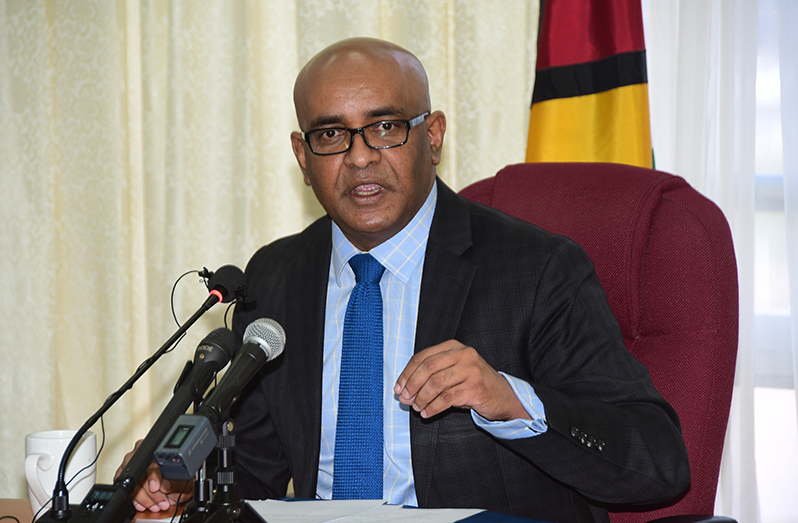– vice-president says new administration does not want ‘flaring’
By Navendra Seoraj
INDUSTRIALISATION and cheap electricity beckons, as the newly-elected People’s Progressive Party Civic (PPP/C) government looks to negotiate with American oil giants, ExxonMobil on a price for natural gas.
ExxonMobil had made significant oil discoveries offshore Guyana, but the “black gold” wasn’t the only treasure they found, as there were associated gas deposits which could be piped to shore.
As reported, the priority, as outlined in the Production Sharing Agreement (PSA) between Guyana and ExxonMobil is oil recovery, but the new administration will be looking to capitalise on the associated gas deposits, so that Guyanese could benefit from cheap electricity, among other things.
Vice-President, Bharrat Jagdeo, said government plans to move ‘swiftly’ with the gas-to-energy project, as their intention is to deliver the promise of cheap electricity, which was made to Guyanese.
It is common knowledge that the cost of electricity in Guyana has been relatively high, and has hindered industrialisaton over the years.
Jagdeo believes that Guyana could have already been on stream to cheaper electricity, but while ExxonMobil was interested in the project, the previous A Partnership for National Unity and Alliance For Change (APNU+AFC) had placed “roadblocks” because they did not respond to the oil company.
“…We want to get this done as swiftly as possible and ExxonMobil , I think, is eager to go along with this project, too, because from what I gather they have been waiting for quite a while for the government to show major interest in moving this forward,” said Jagdeo during a press briefing on Friday.
He said the new administration is studying several reports in order to ascertain why there was no progress on the project. Already, there have been reports that persons would have “bought up” lands on the proposed location for the pipelines, but this is being investigated by the government.
Despite the impediments, the vice-president said government wants to get the project done urgently, even though they will have to be guided by technical people.
“We want to get this done urgently…we have to be guided by technical people, but we want this project on the road as early as possible,” said Jagdeo, adding that there a number of things which need to be decided on.
VERY DIFFERENT
The first order of business will be to negotiate a price for the gas, one that is “very different” from what is in the contract.
While the vice-president did not say what government believes would be a reasonable cost for the gas, he said the contract locks in a price for the gas for the first 300-400 megawatts.
In explaining why government needs the electricity at a different cost, Jagdeo said: “…we need the electricity to industrialise this country and generate more jobs, and fulfill the promise to cut their electricity bill significantly by half of what they are paying now.”
Other critical decisions, which will have to be made, include the ownership of the company that supplies the gas on shore. Some of the possibilities include a public/private partnership, a tender or even a government-owned company.
“We have to make these decisions, but they will be made dependent on the resources available and what the market offers,” said Vice-president Jagdeo.
Although many things are still undecided, the vice-president said government is certain that they do not want gas flaring to continue.
It was reported that ExxonMobil flared over two billion cubic feet of natural gas due to challenges during production start-up. These challenges have since been alleviated with the commencement of the re-injection of gas.
“We are doing all we can to repair the equipment safely in order to complete final commission of the system. As we have said, we have also reduced crude oil production to lessen the amount of gas being flared.
“ExxonMobil’s commitment to minimising the environmental impact of its projects is reflected by our design of the Liza Destiny and Liza Phase One project. Our operations in Guyana will not utilise routine flaring. We are currently still in the start-up period for Liza Phase One which involves temporary flaring to fully commission the gas compression and injection systems, for safe operations as outlined in the approved Environmental Impact Assessment and permit,” said ExxonMobil’s Senior Director of Public and Government Affairs, Dedra Moe, in a past report.
Back in 2019, ExxonMobil had explained to media operatives that for the first period after ‘first oil’, there would be initial start-up flaring – authorised by the EPA – which occurs during the commissioning and initial start-up phases of the FPSO when gas and liquids are introduced into new facilities and equipment.
This flaring, the company said, would not continue as routine and will only take place again in the case of an emergency whereby flaring will be used to immediately de-pressure the facility as part of a shut-down process to reduce risk.
ExxonMobil is now firmly established in Guyana, operating an office in Georgetown, with numerous ongoing exploration and development operations offshore. ExxonMobil Guyana has made 16 discoveries since May 2015 and began production in December 2019 from the Liza Phase One development project.



.jpg)









